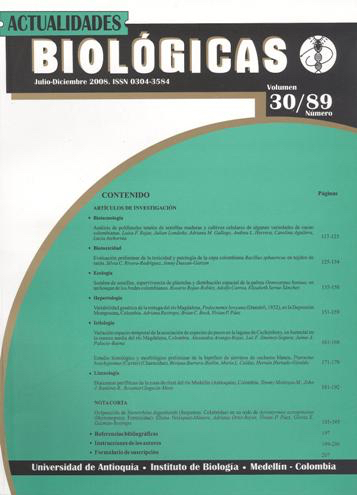Análisis de polifenoles totales de semillas maduras y cultivos celulares de algunas variedades de cacao colombianas
DOI:
https://doi.org/10.17533/udea.acbi.4739Palabras clave:
biotecnología vegetal, metabolitos secundarios, polifenoles, Theobrema cacaoResumen
El propósito de esta investigación fue el establecimiento de suspensiones celulares de cacao (Theobroma cacao) para analizar el contenido de polifenoles totales en dos variedades de cacao colombianas y comparar estos resultados con el contenido total de polifenoles para las mismas variedades de campo. Los resultados finales mostraron que es posible producir gran cantidad de biomasa de cacao capaz de sintetizar los metabolitos sin perder sus propiedades organolépticas (olor, color y sabor), y producir un contenido aceptable de polifenoles totales comparado con las semillas naturales. este estudio preliminar es una perspectiva promisoria para la producción futura de antioxidantes y suplementar con ellos los productos derivados del cacao.
Descargas
Citas
bhojwani ss, razdan mK. 1996. Plant tissue culture: Theory and practice, a revised edition. elvesier scien-ce. Amsterdam.
Cooper K, donovan J, Waterhouse a, Williamson G. 2008. cocoa and health: a decade of research. British Journal of Nutrition, 99(1):1-11.
Cakirer m. 2003. Color as an indicator of flavonol content in the fresh seeds of Theobroma cacao. the penns-ylvania state university. <http://guiltinanlab.cas.psu.edu/publications/cocoa/melisthesis.pdf>. fecha de consulta: 21 de febrero de 2007.
Dixon ra, paiva n. 1995. stress-induced phenylpropanoid metabolism. Plant Cell, 7(7):1085-1097.delledone m, Xia y, dixon r, lamb c. 1998. nitric oxide functions as a signal in plant disease resistance. Nature
(6693):585-588.
Durner J, Gow a, stamler J, Glazebrook J. 1998. Ancient origins of nitric oxide signaling in biological systems. Proceedings of the National Academy of Sciences, 95(25):14206-14207.
Giorgi a, mingozzi m, madeo m, speranza G, cocucci, m. 2009. effect of nitrogen starvation on the pheno-lic metabolism and antioxidant properties of yarrow (Achillea collina becker ex rchb.) Food Chemistry, 114(1):204-211.
Grace sc, logan ba. 2000. energy dissipation and radical scavenging by the plant phenylpropanoid pathway.Philosophical Transactions of the Royal Society B: Biological Sciences, 355:1499-1510
Gurney K, evans l, robinson d. 1992. purine alkaloid production and accumulation in cocoa callus and suspension cultures. Journal of Experimental Botany,43(6):769-775.
Hammerstone Jf, schmitz hh. 1998. cocoa components, edible products having enhanced polyphenol content, methods of making same and medical uses. patent cooperation treaty (pct) Wo 98/09533, mars incor-porated, u.s.A.
Henderson J, Joyce r, halls G, hurst J, mcGovern p.2007. chemical and archaeological evidence for the earliest cocoa beverages. Proceedings of the National Academy of Sciences, 104(48):18937-18940.
Jacobs m, rubery p. 1998. naturally occurring auxin trans-port regulators. Science, 241:346-349.
Jalal m, collin h. 1979. secondary metabolism tissue culture of Theobroma cacao. New Phytologist, 83(2):343-349.
Janick J, pence vc. 1980. method of non-agricultural pro-duction of cotyledons. us patent 4.204.366. Purdue research foundation, West lafayette, in.
Janick J, pence vc. 1981. plant tissue produced by non-agricultural proliferation of cocoa embryos. us patent 4.301.619. Purdue research foundation, West lafa-yette, in.Kim h, Keeney pG. 1984. (-)epicatechin content in fer-mented and unfermented cocoa beans. Journal of Food Science, 49:1090-1092.
Keen c, holt r, oteiza p, fraga c, schmitz h. 2005. co-coa antioxidants and cardiovascular health. American Journal of Clinical Nutrition, 81(1):298s-303s.
Leathers rr, scragg ah. 1989. the effect of different temperatures on the growth, lipid content and fatty acid composition oftheobroma cacao cell suspension cultures. Plant Science, 62(2):217-227.
Loewus fa. 1999. biosynthesis and metabolism of ascorbia acid in plants and of analogs of ascorbic acid in fungi. Phytochemistry, 52:193-210.
Ramachandra s, ravishankar G. 2002. plant cell cultures: chemical factories of secondary metabolites. Biotech-nology Advances, 20:101-153.
Romanczyk lJ, hammerstone, Jf, buck mm, post ls, cipolla GG, micceland ca, mundt Ja, schmitz hh. 1997. cocoa extracts compounds and methods for making and using the same. patent cooperation treaty (pct) Wo 97/36497, mars incorporated, u.s.A.
Seet he. 1973. Plant Tissue and Cell Culture. blackwell Scientific Publications. London, England.
Tsai c, Kinsella J. 1981. initiation and growth of callus and cell suspensions of Theobroma cacaol. Annals of Botany, 48:549-558.
Tsai c, Kinsella J. 1982. tissue culture of cocoa bean ( Theobroma cacaol.): incorporation of fatty acids into lipids of cultured cells. Lipids, 17(12):848-852.
Winkel-shirley b. 2002. Biosynthesis of flavonoids end effects of stress. Current Opinion in Plant Biology,5:218-223.
Wollgast J, anklam e. 2000. review on polyphenols in Theobroma cacao: changes in composition during the manufacture of chocolate and methodology for identifi-cation and quantification. Food Research International, 33:423-447.
Yamasaki h, sakihama y, ikehara n. 1997. flavonoid-peroxidase reaction as a detoxification mechanism of plant cells against H2o2. Plant Physiology, 115:1405-1412.
Yamasaki h, Grace s. 1998. epr detection of phytophe-noxyl radicals stabilized by zinc ions: evidence for the redox-coupling of plant phenolics with ascorbate in the H2o2-peroxidase system. FEBS Letters, 422:377-380.
Descargas
Publicado
Cómo citar
Número
Sección
Licencia
Derechos de autor 2010 Actualidades Biológicas

Esta obra está bajo una licencia internacional Creative Commons Atribución-NoComercial-CompartirIgual 4.0.
Los autores autorizan de forma exclusiva, a la revista Actualidades Biológicas a editar y publicar el manuscrito sometido en caso de ser recomendada y aceptada su publicación, sin que esto represente costo alguno para la Revista o para la Universidad de Antioquia.
Todas las ideas y opiniones contenidas en los artículos son de entera responsabilidad de los autores. El contenido total de los números o suplementos de la revista, está protegido bajo Licencia Creative Commons Reconocimiento-NoComercial-CompartirIgual 4.0 Internacional, por lo que no pueden ser empleados para usos comerciales, pero sí para fines educativos. Sin embargo, por favor, mencionar como fuente a la revista Actualidades Biológicas y enviar una copia de la publicación en que fue reproducido el contenido.












